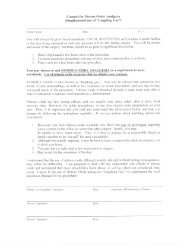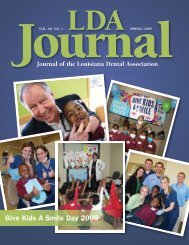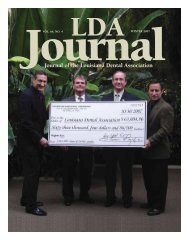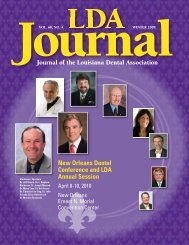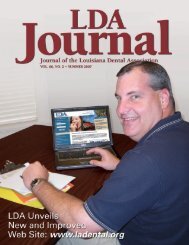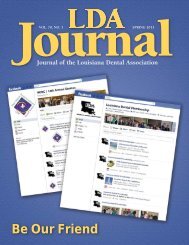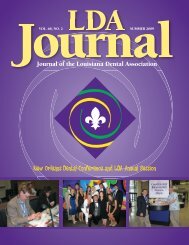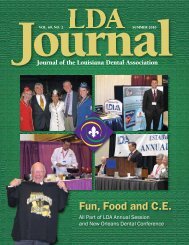Journal of the Louisiana Dental Association Journal of the Louisiana ...
Journal of the Louisiana Dental Association Journal of the Louisiana ...
Journal of the Louisiana Dental Association Journal of the Louisiana ...
Create successful ePaper yourself
Turn your PDF publications into a flip-book with our unique Google optimized e-Paper software.
LDA<br />
from <strong>the</strong> executive director<br />
Ward Blackwell, M.J.<br />
LDA Executive Director<br />
What Your Patients Think about Workforce<br />
If you’re a practicing dentist, a dental auxiliary or even a<br />
dental association staff member, your perception <strong>of</strong> dental<br />
workforce/access issues reflect your knowledge <strong>of</strong>, and<br />
immersion in, <strong>the</strong> world <strong>of</strong> dentistry.<br />
It’s not surprising that <strong>the</strong> public’s perception <strong>of</strong> dental<br />
workforce/access issues differs from yours. And, some <strong>of</strong><br />
those differences can be both surprising and edifying.<br />
Here <strong>the</strong>n are some <strong>of</strong> <strong>the</strong> key findings <strong>of</strong> public opinion<br />
research conducted by <strong>the</strong> firm <strong>of</strong> Chlopak, Leonard and<br />
Shechter for <strong>the</strong> ADA and my opinions <strong>of</strong> <strong>the</strong> implications<br />
for workforce/access public policy debates.<br />
Cost/lack <strong>of</strong> insurance drives <strong>the</strong> public’s concerns<br />
about access much more so than logistics, workforce,<br />
etc. Any proposal that appears to have potential for<br />
reducing costs (e.g., through increased competition) sounds<br />
good to <strong>the</strong> public. This appears to be true even if <strong>the</strong> issue<br />
being addressed is, as typically is <strong>the</strong> case, <strong>the</strong> proximity <strong>of</strong><br />
dentists to underserved populations (e.g., DHATs in Alaska<br />
or <strong>the</strong> large number <strong>of</strong> federally designated dental Health<br />
Provider Shortage Areas in many states).<br />
Managed care, nurse practitioner modes and<br />
relationships to hygienists have reduced concerns<br />
about dental mid-level providers. The numerous midlevel<br />
providers in medicine are already widely accepted.<br />
Plus, most people see hygienists in a similar vein and<br />
tend to assume <strong>the</strong>y have a broader scope <strong>of</strong> practice than<br />
<strong>the</strong>y actually do. This would seem to make it harder to<br />
distinguish what <strong>the</strong> limits <strong>of</strong> scope should be for nondentists.<br />
Strong willingness to expand <strong>the</strong> workforce is<br />
based on a belief it will lead to lower cost options.<br />
This naturally follows from <strong>the</strong> two previous findings.<br />
The proliferation <strong>of</strong> mid-level providers in medicine is<br />
probably associated in <strong>the</strong> public perception with efforts to<br />
reduce costs. Likewise, almost all “competition” is generally<br />
believed to have <strong>the</strong> potential to reduce costs.<br />
Most believe some dental procedures aren’t complex.<br />
No one wants anyone besides a dentist performing a root<br />
canal. However, most people simply don’t view many o<strong>the</strong>r<br />
invasive dental procedures as complex operations that<br />
involve highly specialized knowledge and skill to perform<br />
correctly and safely, just like any o<strong>the</strong>r medical procedure.<br />
Dentists simply make it look easier than it is. So, someone<br />
o<strong>the</strong>r than a dentist performing such procedures is likely to<br />
be more acceptable to <strong>the</strong> public eye.<br />
In terms <strong>of</strong> access solutions “something beats<br />
nothing” virtually every time. While policymakers are<br />
influenced by all <strong>the</strong> public attitudes listed here, this may<br />
be <strong>the</strong> most significant. Public <strong>of</strong>ficials want to be seen as<br />
doing something about a problem whenever possible, and<br />
this attitude clearly feeds that. Merely framing a proposed<br />
solution as less than optimal (e.g., “Mid-levels will provide<br />
substandard care.”) is <strong>the</strong>refore unlikely to be persuasive.<br />
To <strong>the</strong> degree possible, proposing superior alternatives that<br />
are easily understood would appear to be a more effective<br />
strategy, especially if <strong>the</strong>y can be readily implemented.<br />
Less willingness to choose one option over ano<strong>the</strong>r;<br />
more willingness to experiment. This is <strong>the</strong> corollary to<br />
<strong>the</strong> previous point. There is a tendency for <strong>the</strong> public (and<br />
<strong>the</strong> lawmakers <strong>the</strong>y elect) to say “approach ‘A’ sounds good,<br />
but why not try ‘B’ as well? Even if it’s less than ideal, it<br />
can’t hurt and doing both addresses more <strong>of</strong> <strong>the</strong> problem.”<br />
This is an especially difficult attitude to confront when<br />
scarce resources make a less expensive, apparently simpler<br />
solution more appealing.<br />
Expanded workforce debates break on two lines:<br />
scope and supervision. Scope is <strong>the</strong> tougher fight – <strong>the</strong><br />
public is unaware <strong>of</strong> <strong>the</strong> complexity <strong>of</strong> basic dentistry;<br />
supervision, with dentist at <strong>the</strong> head <strong>of</strong> <strong>the</strong> team, is our<br />
strongest suit. Reports from advocacy battles all across<br />
<strong>the</strong> country bear out that preventing <strong>the</strong> creation <strong>of</strong> new<br />
dental “mid-level providers” is a daunting proposition.<br />
And, educating policymakers and <strong>the</strong> public about <strong>the</strong><br />
complexity <strong>of</strong> dentistry (i.e., viewing dentists as doctors)<br />
may be quite a challenge. Still, our “strong suit” makes it<br />
difficult to envision any scenario in which dentists are not<br />
ultimately in control <strong>of</strong> <strong>the</strong> delivery <strong>of</strong> oral health care.<br />
On all workforce/access issues, <strong>the</strong> LDA leadership is<br />
committed to maintaining <strong>the</strong> highest possible standard<br />
<strong>of</strong> care for <strong>Louisiana</strong> dental patients. That’s why we try<br />
to glean as much as possible from this sort <strong>of</strong> research<br />
and continue to work with <strong>the</strong> Austin Group developing<br />
strategies to fur<strong>the</strong>r that objective. Be sure to check <strong>the</strong><br />
LDA website regularly for updates and to learn ways to<br />
show YOUR commitment.<br />
10 LDA <strong>Journal</strong>



